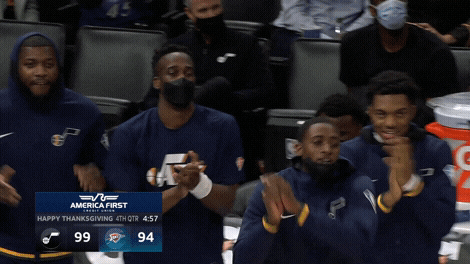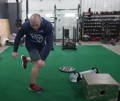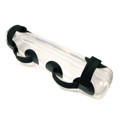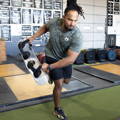Best Drills for Juking in Football
FREE SPEED & POWER WORKOUT!
Download by entering below

3 Best Drills To Improve Agility & Athletic Strength
The exercises we are going to be going over are drills that will improve athletes’ jukes. We think of jukes as an athlete becoming shifty to cut a specific way. The athlete wants to put their center of mass at a lower position with a steeper shin angle to be able to move quickly so the opponent can’t gain an advantage. Wrestlers avoid being taken down or a basketball player Euro-stepping to the bucket. Whatever sport it is, a juke is a movement that sets the position up to fake out an opponent.
Chunking
The first principle we have to understand is chunking. Based on the principle of chunking, we can teach jukes in the weight room by looking at video highlights of some of the best cuts or jukes athletes have ever had and break down the movements, bringing it back to the first 2 to 4 steps to chunk the juke. From there, we can go even deeper and go from just the first step to the second step. As the athlete masters the first two steps, we can then bring in the third step and so on. In this manner, we are using chunking in the weight room to develop the mechanisms around central pattern generators.
Central pattern generators are brain motor neurons that exist on the spine and essentially control rhythmic movements like walking, swimming, jogging, sprinting, or movements that aren’t thought about. They all use central pattern generators. The idea behind developing central pattern generators for other movements is to take command-driven tasks (where we are thinking, “I’m going to get into this position and do this first movement”) and lead to the CPGs taking over to enhance agility and athletic strength.
The entire goal is to take these crazy jukes and turn them into semi-autonomous movements. Central pattern generators are autonomous movements: breathing, coughing, and even throwing up, plus the athletic side of things we discussed. The command part is the commencement of the semi-autonomous movements to signal the jukes and enhance athletic strength.
Let’s take a look at the exercises
1. Heiden Jumps
Eric Heiden won a whole bunch of Olympic medals in speed skating. The Heiden jump series requires that the body learns how to decelerate through angular changes of direction. A simple chunking method to teach this movement requires pausing. The movement begins by standing on a 12” box. Step off the box and land on a single leg. Pause in the landing to first learn the pattern at a slower pace. From the pause, jump laterally off the single leg and land on the opposite leg. Again, pause on the single leg. After this pause, jump forward off the new single leg and land on both feet.
The simple chunking method of pausing on each step and stopping on the finish is four steps. Learning things at a slower pace can be more complex. Doing things faster, we have to be more precise with the movement. The pauses create a focus on the deceleration and the co-contraction between the knees and hips. As the body warms up and starts to master the series of jumps, working through the chunking (which can happen in one session, over weeks, or months–it all depends on the athlete’s strength level and skill level), we can speed the jump series up.
As the movement is sped up and the athleticism of performing the movement is passing the eye test, we can start to add target lines to give distances to aim for to become more precise, more powerful, more explosive, and ultimately more athletic with greater agility capabilities.
Heiden jumps are great for basketball players, ice skaters, and football players. It is something that helps athletes change direction and move quickly. Upon improvement, adding double leg bounds on the end is helpful. Feel free to start adding head movements into the jump series to make it more likely to fake an opponent out.

2. Weighted Euro Step
This is a reflexive movement that can be used for basketball but can also be used for football, wrestling, and even soccer.
To start learning this movement, we want to focus on chunking the movement into two different parts. Holding a 5k plate in both hands, step off an 8” box with the outside leg and pause on the single leg. The inside leg needs to be in a hip lock position.

The next thing to focus on involves starting from the ground. Have the plant leg up in a hip lock, bring the hip locked leg down, plant, and then step with the initially grounded leg to an elevated box. Hold the non-planted leg in a 90/90 hip lock.
We then put the two chunks together. The movement gets more complicated as everything is put together. The movement can also be performed with a water bag, which makes it much more challenging.
This exercise is training multiple, different things at once. It is training deceleration, reactiveness, agility, co-contractions, dynamic trunk control, and a cross-extensor reflex. A lot of birds are being knocked out of the sky with this one movement.

3. Sanders Cut To Box
Named after Barry Sanders, this movement demands chunking in its full effect. Start by doing the movement with just body weight. Ideally, keep the hips, or at least the shoulders, square. The foot being juked off of will hit an extreme pigeon toe while the hips are lowered behind the front foot.

As the declaration and stability in the pigeon toe landing are solidified, the athlete will then be able to do the next part of the chunk and step up onto a box. It is important athletes are strong enough to handle these positions. This is where absolute strength and bodybuilding work come into play. With the bodyweight mastered, we can then add a plate. The plate is pushed out to help the body get lower before the sharp 90-degree cut into the step onto the box. Performing the step onto the box, we want to elevate the plate up over our head similar to a snatch. The movement needs to be powerful and deliberate.
For the most advanced athletes, this movement can be done with the Hydro Weight to make the dynamic trunk control work more demanding.
Recap
Understanding the development of jukes through the principles of chunking is a must. Understanding the theory behind central pattern generators and how they impact movement allows us to take command-driven tasks and unite the two to have semi-autonomous movements come into play. All of that said, performing the three exercises above will improve an athlete’s agility and athleticism in competition.
Related Posts
Blog Topics

Yo, It's Dane
Welcome to the Garage Strength Blog, where it is my goal to provide you with the experience and knowledge I've gained in the strength and conditioning world over many years of learning from both successes and failures. I train elite-level athletes in a multitude of sports from the high school to professional levels, already producing 5 Olympics and 30+ National Champions. If you want to be the next champion I train, check out my strength programs below!
Start Training With Me

Join for free educational videos EVERY WEEK on strength coaching and athletic performance





